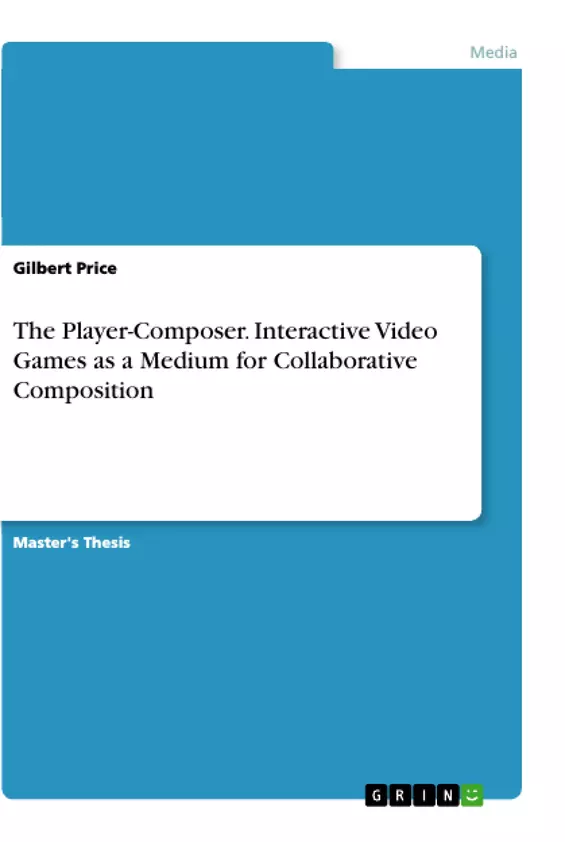This dissertation explores how players’ interaction and engagement with video games affect their musical content.
The author builds principally upon previous research undertaken by Elizabeth Medina-Grey concerning video game music’s modular compositional process. He claims that the players of video games, though their vital role in the final realization of video game scores, act not merely as instruments in the composer’s vision but as co-composers in themselves.
The dissertation is in three parts. In the first part He will be explicating relevant scholars’ work, with some discussion and critique. The second part is devoted to an in-depth case study of the compositional process of the 2014 puzzle game Hexcells, to which He will apply theories and concepts explained in the first part. The final part is an extended discussion based on the findings in part two, ending with conclusions and implications.
Inhaltsverzeichnis (Table of Contents)
- Abstract
- Introduction
- Part 1: Background
- Chapter 1: The History of Video Game Music
- Chapter 2: The Evolution of Interactive Music
- Chapter 3: The Role of the Player in Video Game Music
- Part 2: Case Study: Hexcells
- Chapter 4: Game Mechanics and Design
- Chapter 5: The Musical Score of Hexcells
- Chapter 6: Player Interaction and Musical Outcomes
- Part 3: Conclusion
Zielsetzung und Themenschwerpunkte (Objectives and Key Themes)
This dissertation investigates the interactive nature of video game music, focusing on how player interaction shapes the musical experience. It builds upon existing research on modular composition in video games, arguing that players are not simply passive recipients of the composer's vision but actively participate in the creation of the soundtrack.
- The role of the player in shaping the musical experience of video games
- The concept of modular composition in video game music
- The dynamic and adaptive nature of video game scores
- The impact of player 'playstyle' on musical outcomes
- The analysis of a specific video game (Hexcells) as a case study
Zusammenfassung der Kapitel (Chapter Summaries)
- Chapter 1: The History of Video Game Music This chapter explores the evolution of video game music, tracing its origins and development through different generations of games. It examines the transition from simple sound effects to complex musical scores and the increasing sophistication of game music technology.
- Chapter 2: The Evolution of Interactive Music This chapter discusses the emergence of interactive music, highlighting the shift from static soundtracks to dynamic and responsive musical experiences. It explores the development of music engines and their role in creating a sense of interactivity within video games.
- Chapter 3: The Role of the Player in Video Game Music This chapter examines the significance of player interaction in shaping the musical experience of video games. It argues that players are not merely passive listeners but active participants in the musical creation process. It analyzes the various ways in which player actions, preferences, and decision-making influence the musical outcomes.
- Chapter 4: Game Mechanics and Design This chapter provides a detailed analysis of the game mechanics and design of Hexcells, a minimalist puzzle game. It explores how the game's interface, gameplay elements, and puzzle structure contribute to the overall player experience.
- Chapter 5: The Musical Score of Hexcells This chapter analyzes the musical score of Hexcells, examining its structure, composition, and its use of modular elements. It investigates how the music integrates with the game's mechanics and contributes to the player's engagement.
- Chapter 6: Player Interaction and Musical Outcomes This chapter investigates the relationship between player interaction and the musical outcomes in Hexcells. It explores how different player strategies, choices, and approaches affect the music that is generated, highlighting the individual nature of the musical experience.
Schlüsselwörter (Keywords)
The dissertation focuses on the key concepts of interactive video game music, modular composition, player agency, dynamic music, and ludomuscicology. It examines the role of players as co-composers in shaping the musical experience of video games, particularly through the case study of Hexcells.
- Quote paper
- Gilbert Price (Author), 2019, The Player-Composer. Interactive Video Games as a Medium for Collaborative Composition, Munich, GRIN Verlag, https://www.grin.com/document/1000737



